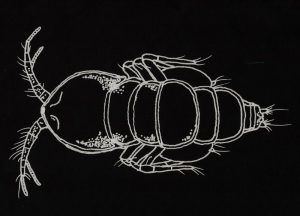Several months ago, I obtained 10 SPS frags from a seller on Ebay. At the time, I had 8 frags already in my Q-tank. All frags were dipped with my usual procedure:
-50:50 mix with seller’s and my water; 10 minutes with pinch of Interceptor
-Transfer to container with Coral RX: 1.25 ml per cup for 5 min.
-Transfer to container with Bayer: 5ml per cup for 20 min.
After about 5 days, I noticed a Romel’s Watermelon starting to look “moth-eaten.” I performed another set of dips and under an operating microscope I found a couple of copepods that looked like “Red Bugs” but were smaller and brown. I am quite certain they are related, in the Tegastes genus, because of their similar “flea-like” appearance. Hopefully, someone may have an idea what the proper name is for these parasites; but for now, I will refer to them as “Brown Bugs” for lack of a better name. (Unfortunately, I was not able to get a photo of them using my iphone camera thru the microscope).
I added 0.5 cc of IVERMECTIN 1% injectable solution to the container harboring 2 of these parasites (in 2 oz water). IVERMECTIN is used primarily to treat intestinal (and tracheal) worms in animals but it also works very well to treat mites (e.g. “Scaley Face” in parakeets or “Air Sac Mites” in canaries). Copepods and mites are both arthropods which ivermectin targets.
After 8 hours, the bugs would still scoot around when disturbed, but were dead the next morning (about 16 hours). This dose and length of dipping time would not be practical, of course, but it does suggest that IVERMECTIN may have some deleterious effect on the parasite.
I then added 2cc of IVERMECTIN to the 30 gal Q-system, once a day for 3 consecutive days. I also ordered an organophosphate, Dyacide, which arrived 1 week later. At this time, I dipped the frags again and found 2 more live bugs (with the aid of an operating microscope), one in a mucous-like mass on the frag. These bugs are very difficult to find. Unlike Red Bugs, they can’t be seen with the naked eye. So, I suspected that there were probably more in the tank along with eggs.
I decided to use an organophosphate because of an unrelated, but interesting experience I had over 16 years ago (which I will describe at the end of this post). DYACIDE comes as a powder in a bottle. You just fill the bottle with RO/DI water to the top and dose 2 drops per gallon for 3 consecutive days. The problem was that I wanted to repeat this treatment regime for a total of 3 weeks but the solution is only stable for 3 days once constituted. So, I removed the powder from the bottle and weighed it (0.57 gms) and measured the volume of the bottle (34 ml). I calculated that I should dose 0.06 gms of powder in the 30 gal tank for each dose. (Note that it is difficult to measure this minute amount very accurately). This way, I could stretch out the treatment for the 3 weeks.
My hopes were that the combination of relatively low doses of TWO compounds would be safer AND more likely to eliminate these bugs than by using just one drug alone. 10% water changes were performed before each treatment and that was continued (once-a-week) afterwards. After the third week of treatment, I examined the frags at least once a week for several weeks and found no more parasites. But, because of the difficulty finding these parasites, I waited another 3 months before moving the frags to my main tank just to play it safe. I did lose the Rommel’s watermelon, but it was in bad shape to begin with. I also lost a Hawkins ecchinata and Ponape Bird’s Nest, but I suspect that they couldn’t handle all the dips. All the other frags survived, including some “high end” frags (e.g. Lady in Pink; ASD Rainbow mille; JF solar flare and Highlighter; TSA Fruity Pebbles; WWC All Star) although most “browned out” during the stressful time in the Q-tank. All the corals are looking better now, 1 month after moving to my main tank and I am convinced that all the parasites are gone.
Products I used:

NOTES:
Here is a photo (taken 16 years ago) of the parasitic FISH ISOPOD.
THIS IS NOT THE “BROWN BUG” I DESCRIBED ABOVE !!
(Unfortunately, my “modern-day” iphone would not let me take a photo of the Brown Bugs thru the same microscope I used 16 years ago when I had a “cheap” camera phone used for the photo below!)

-50:50 mix with seller’s and my water; 10 minutes with pinch of Interceptor
-Transfer to container with Coral RX: 1.25 ml per cup for 5 min.
-Transfer to container with Bayer: 5ml per cup for 20 min.
After about 5 days, I noticed a Romel’s Watermelon starting to look “moth-eaten.” I performed another set of dips and under an operating microscope I found a couple of copepods that looked like “Red Bugs” but were smaller and brown. I am quite certain they are related, in the Tegastes genus, because of their similar “flea-like” appearance. Hopefully, someone may have an idea what the proper name is for these parasites; but for now, I will refer to them as “Brown Bugs” for lack of a better name. (Unfortunately, I was not able to get a photo of them using my iphone camera thru the microscope).
I added 0.5 cc of IVERMECTIN 1% injectable solution to the container harboring 2 of these parasites (in 2 oz water). IVERMECTIN is used primarily to treat intestinal (and tracheal) worms in animals but it also works very well to treat mites (e.g. “Scaley Face” in parakeets or “Air Sac Mites” in canaries). Copepods and mites are both arthropods which ivermectin targets.
After 8 hours, the bugs would still scoot around when disturbed, but were dead the next morning (about 16 hours). This dose and length of dipping time would not be practical, of course, but it does suggest that IVERMECTIN may have some deleterious effect on the parasite.
I then added 2cc of IVERMECTIN to the 30 gal Q-system, once a day for 3 consecutive days. I also ordered an organophosphate, Dyacide, which arrived 1 week later. At this time, I dipped the frags again and found 2 more live bugs (with the aid of an operating microscope), one in a mucous-like mass on the frag. These bugs are very difficult to find. Unlike Red Bugs, they can’t be seen with the naked eye. So, I suspected that there were probably more in the tank along with eggs.
I decided to use an organophosphate because of an unrelated, but interesting experience I had over 16 years ago (which I will describe at the end of this post). DYACIDE comes as a powder in a bottle. You just fill the bottle with RO/DI water to the top and dose 2 drops per gallon for 3 consecutive days. The problem was that I wanted to repeat this treatment regime for a total of 3 weeks but the solution is only stable for 3 days once constituted. So, I removed the powder from the bottle and weighed it (0.57 gms) and measured the volume of the bottle (34 ml). I calculated that I should dose 0.06 gms of powder in the 30 gal tank for each dose. (Note that it is difficult to measure this minute amount very accurately). This way, I could stretch out the treatment for the 3 weeks.
My hopes were that the combination of relatively low doses of TWO compounds would be safer AND more likely to eliminate these bugs than by using just one drug alone. 10% water changes were performed before each treatment and that was continued (once-a-week) afterwards. After the third week of treatment, I examined the frags at least once a week for several weeks and found no more parasites. But, because of the difficulty finding these parasites, I waited another 3 months before moving the frags to my main tank just to play it safe. I did lose the Rommel’s watermelon, but it was in bad shape to begin with. I also lost a Hawkins ecchinata and Ponape Bird’s Nest, but I suspect that they couldn’t handle all the dips. All the other frags survived, including some “high end” frags (e.g. Lady in Pink; ASD Rainbow mille; JF solar flare and Highlighter; TSA Fruity Pebbles; WWC All Star) although most “browned out” during the stressful time in the Q-tank. All the corals are looking better now, 1 month after moving to my main tank and I am convinced that all the parasites are gone.
Products I used:
NOTES:
- When using DYACIDE (an organophosphate) do not touch the chemical OR treated water with your skin. (Supposedly, though, the chemical breaks down in a “short” time in water).
- Because of the limited number of parasites I had available to work with, I was limited with the extent of my experimentation. But I think that the combination of these two drugs should be considered for anyone having problems with any stubborn “bug” (e.g. Black Bugs). With further experimenting, fine-tuning dosages may be possible.
- One of the most exciting things I found: Just a couple hours after 2cc of IVERMECTIN was added to the 30 gal Q-tank, an 8” Fire Worm emerged from a rock in a very weakened state and just laid on the bottom of the tank. Some of you may recall my thread on Fire Worms killing over 30 SPS frags before I figured out that they were the culprit! I thought I got rid of them long ago, but apparently not. The fire worms came in with 2 batches of KP rock a couple of years ago. I do plan to buy more of this rock but will treat a “rock Q-tank” with Ivermectin @ 2-4 cc/30 gal to get rid of them. They are a nightmare and I am VERY happy that I found a way to deal with them!
- My Past Experience with Organophosphates: 16 years ago, I used to buy fish from a local wholesaler for my small pet shop associated with my vet hospital. There was a time when practically every fish purchased, in 2 or 3 batches, died and it wasn’t from the common parasites for which I always treated. Finally, I isolated parasitic isopods on some of the fish. At the time, there was a powdered organophosphate product (Trichlorfon) available that came in a jar which was easy to dose. Apparently, this product is no longer available so I chose the closely related DYACIDE (Dimethyltrichlorophosphonate) to treat the “Brown Bug” infestation. Since the Trichlorfon worked great to eliminate the fish isopods, I guessed and hoped that the “Brown Bug” might be killed by the DYACIDE since isopods and copepods are so closely related. (I told the wholesaler about this parasite and offered assistance to treat his facility but I was ignored. Two months later, they went out of business!)
- Snails, sponges, tube worms (and aiptasia) all seem to be spared during the above-mentioned treatment.
Here is a photo (taken 16 years ago) of the parasitic FISH ISOPOD.
THIS IS NOT THE “BROWN BUG” I DESCRIBED ABOVE !!
(Unfortunately, my “modern-day” iphone would not let me take a photo of the Brown Bugs thru the same microscope I used 16 years ago when I had a “cheap” camera phone used for the photo below!)




















